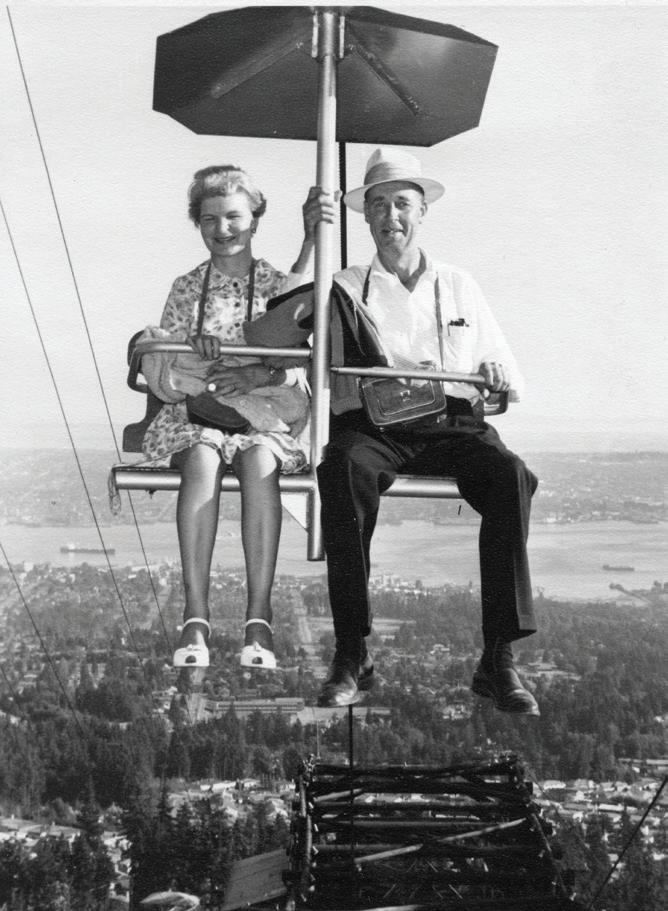



NYA SVENSKA PRESSEN EST.1929 Swed sh Pre s s [ ] i Swedes in British Columbia | The Sport of Wife-Carrying | Meet Patrik Allvin www.SwedishPress.com June-July 2023 Vol 94:03 $9.95 03 2023 Nordic Heritage in BC
Swedes in BC
BeforeCanada became a country in 1867 there were Swedes living in British Columbia. At the turn of the century, BC had the most Swedishborn nationals of all the Canadian provinces. They settled wherever opportunities for jobs and land presented themselves. Like other immigrants, they were expected to conform to the language and customs of the Englishspeaking majority. Many suppressed their Swedish identity and assimilated so well that they became known as “the invisible immigrants”.

Not much is known about them, but these photos, from the “Swedes in BC” photographic exhibition (and book), offer a rare glimpse into the lives of some of these early Swedish settlers. All photos are published with the permission of the Association for Swedish Heritage in BC.


[History]
Trappers Oona River, 1912. John and Adolf Bergman were born close to Nyland, Västerbotten. John came to Canada in spring 1911. His two brothers were already in Prince Rupert.
World Champion Rock Drillers, Rossland BC. Joe Johnson and Algot Erickson were so proficient with the 8 lb hammer and drill steel they could average better than a blow a second, with hardly a break in the pace when they switched positions.
Rossland BC, 1905. Joseph (Jonas) Johnson was born in Bjuråker in 1883. His father’s name was Johan Fransson Bjurling. His widowed mother with four children immigrated to The Dalles, Oregon in 1892 where she had relatives. Joseph and his siblings moved to Canada in 1907. Joseph moved to Silverton where he teamed up with another Swede, Algot Erickson, for the sport of rock drilling.
Swedish Press | June-July 2023 | 22
Solomon Bergman having a smoke, 1917. Solomon Bergman was born in 1868 in Tännäs, Härjedalen. He left Sweden in 1913 and came first to Prince Rupert, then Hazelton where he worked as a time keeper in a logging camp. This picture was taken in the Hazelton area.




Carl Borg, Matsqui 1921. Carl Borg was born in Gränna. He immigrated with his parents and 9 siblings to Matsqui in 1912. They were 20 people travelling together. In Liverpool they asked to buy 20 tickets on the next boat out. There were no tickets left, so they had to wait for the next sailing. The name of the first ship they hoped to board was The Titanic.

 Gentlemanly art of “Fingerkrok” 1930s. Swedish Park, North Vancouver. Helmer Staffanson came to BC in 1925. Olaf Malmquist immigrated in the early 1900s to BC. Both of these families settled in Silverhill.
Hulda Bennett (nee Linquist) in her $1500 mink coat, 1932. Hulda at the corner of 300 block, West Pender Street, Victory block, Vancouver.
Grouse Mountain Chair Lift, Vancouver, ca. 1950. Elof and Elsie Kellner. Elof was born in Stocka, Hälsingland and left Sweden in 1927.
Stanley Park, Hollow tree, 1930. From left to right: Eric Erickson, unknown lady, Solomon Bergman, unknown man, Ida Erickson Berglund. Solomon Bergman was born in 1868 in Tännäs, Härjedalen and left Sweden in 1913. He had a book and record store in the Hastings/Main area.
Gentlemanly art of “Fingerkrok” 1930s. Swedish Park, North Vancouver. Helmer Staffanson came to BC in 1925. Olaf Malmquist immigrated in the early 1900s to BC. Both of these families settled in Silverhill.
Hulda Bennett (nee Linquist) in her $1500 mink coat, 1932. Hulda at the corner of 300 block, West Pender Street, Victory block, Vancouver.
Grouse Mountain Chair Lift, Vancouver, ca. 1950. Elof and Elsie Kellner. Elof was born in Stocka, Hälsingland and left Sweden in 1927.
Stanley Park, Hollow tree, 1930. From left to right: Eric Erickson, unknown lady, Solomon Bergman, unknown man, Ida Erickson Berglund. Solomon Bergman was born in 1868 in Tännäs, Härjedalen and left Sweden in 1913. He had a book and record store in the Hastings/Main area.
Swedish Press | June-July 2023 | 23
Meet Patrik Allvin, the NHL's First Swedish GM
 By Kajsa Norman
By Kajsa Norman
When he first moved to Vancouver in early 2022, Patrik Allvin knew that Canadians loved their hockey, but he didn’t realize just how much.
“It didn’t take long before people started to recognize me around town,” he says. “The Canucks fans are so passionate. Hockey just means so much and it’s incredible to be able to be a part of that.”
Growing up in Leksand, Allvin’s life revolved around hockey from an early age.
“There wasn’t much else to do,” he laughs. “I was five or six years old when I started playing.”
While he never made the NHL, in the mid-90s, Allvin did come over to North America to play two seasons in the semi-pro leagues. He played for Nashville Knights and Florida-based Pensacola Ice Pilots in the East Coast Hockey League (ECHL), as well as for the Atlanta Knights and Quebec Rafales in the now dissolved International Hockey League (IHL).

“It was a great experience to head to North America and learn how to
look after myself,” says Allvin who was 20 years old when he left Leksand.
“The year with Pensacola was incredible. The arena held 8,000 spectators and was sold out for each game. We had a great team and lived right on the beach,” he recalls.
That said, it wasn’t all sunshine. “Back then the lower leagues could be quite rough and not very accepting of European players. You were constantly tested physically. You had to learn to stand up for yourself,” he says.
Allvin participated in his share of fights and has described himself as a
[Sport]
Patrik Allvin won three Stanley Cups with Pittsburgh Penguins.
Swedish Press | June-July 2023 | 18
Patrik Allvin left Leksand for North America in 1994. Photos: Private
dirty player.
“I didn’t have great skills, so I had to contribute other things,” he says. “There was definitely more fighting back then and I did some things I wish I hadn’t, but in the heat of the moment it was all about winning.”
Allvin quickly earned the respect of his teammates, and the experience certainly toughened him up. During his first year back in Sweden’s Division 1 league, he registered 139 penalty minutes in 28 games, more than any other defenceman in the league.
While the rest of his career was mainly spent in Sweden, Allvin also played five months in Norway’s top hockey league for Sparta Sarpsborg. At the age of 28, a knee injury put an end to his time as a player. His hockey career, however, was just beginning.
He was soon hired as a European scout for the Montreal Canadiens, and later as Head European scout for the Pittsburgh Penguins, with whom he won three Stanley Cups.
In 2017, he was named director of amateur scouting in North America for the Penguins. This time, moving back to the US from Sweden, he brought along his wife Marie and their children Agnes and Adam.
Marie is a midwife, and professor of Global Reproductive Health at Karolinska Institutet and Dalarna University. She and Patrik went to the same daycare in Leksand and have been a couple since their teenage years. Marie always supported Patrik in his worldwide hockey pursuits. Still, when his former boss in Pittsburg asked him to join him in Vancouver and become the first Swedish GM in the history of the NHL, he hesitated.
“I was a little Swedish I suppose, but a good friend of mine who is GM in the league encouraged me to take
the leap and I am very proud and grateful for the opportunity.”
The move worked out well – the family is thoroughly enjoying living in Vancouver. The Sedin twins, who work for the Canucks as special advisors, also helped the Allvin family get settled in Vancouver. 14-year-old Adam plays hockey and 16-year-old Agnes recently picked up competitive skiing. Both have their hearts set on staying in North America for university.
While Allvin works seven days a week, he strives to delegate and exercise as much as possible to ensure he has the energy to put in the long hours the job demands.
“And I don’t read the newspapers,” he laughs.
When the Swedish Press catches up with Allvin at the Rogers Arena, the Vancouver Canucks have just secured their first victory under new coach Rick Tocchet. The media has closely reported on every step of the staff changing process and Allvin’s face has become familiar to hockey fans across the continent.
While he isn’t one to shy away from the cameras, Allvin wasn’t prepared for just how much media focus there would be on him as a person.
“It’s a team effort, but at the end of the day, as General Manager I am responsible for the team and their performance – players and staff.”
And while his heart is set on winning a Stanley Cup with the Canucks, Allvin recognizes that change takes time.
“I focus on processes and care less about the short-term wins and losses,” he says.
His vision is to rejuvenate the organization through finding young talent that they can help develop.
The Canucks are currently one of
the youngest teams in the NHL and when we meet, Allvin is opting out of attending the upcoming Canucks game in Seattle in favor of watching some local young prospects play. It is obvious he still enjoys the scouting part of the job.
“Watching these 17-year-olds, you have to try to project what they will be like at 22 or 23. They will all be big and strong by then, so it’s more about trying to discern who has better skills, sense of the game, drive, and passion,” he says.
Last summer, the ice was packed with young Swedish players participating in the Canucks development camp, and Canadian media joked that perhaps the camp should be held in Sweden next time.
Allvin claims this was purely circumstantial and that there is no conscious effort to recruit Swedes.
“Regardless of country or region, we focus on the best players,” he says. That said, the Vancouver Canucks have certainly seen their fair share of Swedish players over the years.
“Daniel and Henrik [Sedin] told me they had seven Swedish teammates at one point,” says Allvin “The history of good Swedish players over the years has certainly made my job easier as there was already a great deal of respect for Swedes in the organization.”
Currently, there are only two Swedish players on the team: Elias Pettersson from Sundsvall and Oliver Ekman-Larsson from Karlskrona, plus another three in the Canucks’ minor-league team in Abbotsford. Is there a future Swedish hockey legend among them?
“They definitely have great potential, and it will be up to us to help them reach it,” Allvin concludes.
Swedish Press | June-July 2023 | 19
The Finnish Sport of Wife-Carrying
Carry a woman through an obstacle course and win her weight in beer! There’s no need to travel to Finland to practice the ancient sport of wife-carrying. Every year, the Scandinavian Center in British Columbia hosts this hilarious competition where size truly matters.
 By Kajsa Norman
By Kajsa Norman
Wife carrying (eukonkanto in Finnish or kärringkånk in Swedish) is a Finnish contest in which male competitors race through an obstacle course while carrying a woman, who may or may not be their partner. Some claim the tradition dates to the late 1800s when a man named Herkko Rosvo-Ronkainen, better known as Ronkainen the Robber, would roam the forests with his gang of thieves stealing food and abducting women from nearby villages, supposedly carrying them on their backs as they ran away. Others mention a more generic practice of “wife stealing” among young Finnish men in the olden days. If the woman one wanted
was already taken, she would have to be stolen away. No matter its origins, eukonkanto was first introduced as an official sport at Sonkajärvi, Finland. Since 1992, the annual Wife Carrying World Championships have been held there. First prize is the “wife's” weight in beer.
The International Wife Carrying Competition rules stipulate that: “The wife to be carried may be your own, or the neighbour's, or you may have found her further afield; she must, however, be over 17 years of age.” The minimum weight of the wife is 49 kilograms. A wife lighter than that will have to wear a backpack with additional weight such that the total load is 49 kg. There are several types of car-
rying techniques allowed: the classic piggyback, the fireman's carry (over the shoulder), or Estonian style (wife upside-down on his back with her legs over the neck and shoulders).
Inspired by this tradition, FinnishCanadian Karina Linder, President of the Vancouver-Finlandia club, suggested that Finns in British Columbia should incorporate the sport into the annual Scandinavian Midsummer Festival in Burnaby. That was 12 years ago, and the event quickly developed into a crowd favorite.
“’Husband’ and ‘wife’ are the entries, but we always put them in quotations because you don’t have to be married. You don’t even have to know each other as long as you’re will-
Swedish Press | June-July 2023 | 16
Pauli Juoksu prefers the fireman´s carry. Photo: Courtesy of Scandinavian Community Centre Burnaby, BC.
ing to carry or be carried through the course,” says Karina.
David Moulton, emcee for the event, points out that the Canadian version has no gender bias.
“You can be same sex as long as you identify somebody as ‘the husband’ and somebody as ‘the wife’, that’s all that’s required,” he says.
The Canadian age limit also differs from the Finnish one. You have to be 18 and up to enter, and of legal drinking age – which is 19 in British Columbia - to take the beer home.
Karina and her Swedish husband Daniel participate every year. They have even competed in the World Championships in Finland, which features a permanent, more advanced course.
“It has a waist-deep water hazard, an uphill and a switchback,” says Karina. “We do the Estonian carry technique, an upside-down piggyback which allows me to wrap my arms around his torso, making it easier to hold on. But it is a little bit intimidating when you can’t see where you’re going. You don’t know what’s going on or how much you have left. You have to have a fair amount of trust in your partner – and wear a helmet!”
While there are some who take it very seriously, it is also possible to show up and register for the World Championship upon arrival. While the race itself is short, the event is part of a festival which lasts a full weekend.
“There were about 40 teams in our category. It took us 1 min and 40 seconds to complete the course, while the winners did it in about 40 seconds,” says Daniel.
In Burnaby, it is he who sets the course, and it varies each year so that previous competitors don’t have an advantage. Some years it’s a longer
sprinting course, while other years it might be a shorter but more technical course. It does, however, always feature a water hazard of some kind, typically an inflatable pool that the competitors will have to splash through, an obstacle they will need to step over, as well as a turnaround point or loop to go through.
“One year it was raining a lot and a bus got stuck on the field, so we had to work it into the course,” Karina laughs.
Volunteers dressed up as trolls demonstrate how the course should be completed, usually eliciting a few good laughs from the crowd.
“The falls are the crowd favorites, especially when they occur in water or when the partner gets dropped and is scrambling to get back on. We’ve had a penalty for falling in the past but realized over time that if you make that mistake, you’re not going to win anyway since it is all about speed. A couple of times, people who were struggling have switched partners halfway through the race just to be able to finish,” says Karina.
“It’s a weight thing. It’s tough when someone is a bit heavier, but if they’re too light that’s no good either as you’re not going to win that much beer,” says Pauli Juoksu, President of Finland House, and a regular competitor.

During the COVID-19 pandemic, the organizers encouraged people to film themselves carrying out the race at home on a DIY course. While he didn’t win, Pauli became a COVID crowd favorite when he submitted a video of himself racing with an inflatable doll.
“It had to be COVID compliant,
so I couldn’t find a real wife. I used a modified Estonian carrying technique since she couldn’t hold on,” Pauli laughs.
He is adamant that the Estonian position is the fastest since the carrier is the free to use their arms to run.
“The piggyback is the slowest. When you see someone doing the piggyback you know right away it’s their first time because the runner can’t use their arms,” he says.
Personally, Pauli prefers the fireman’s carry.
“I usually do that one because it’s easiest on the partner and I don’t have a regular partner. The person I carried last year didn’t like the Estonian position; it gave her a headache. We hadn’t had time to practice. Karina had arranged the wife for me, and I only met her at the starting line.”
About 20 teams compete each year at the Scandinavian Centre in Burnaby, BC. While it is possible to sign-up on the day, the organizers recommend those interested in participating to register in advance as there is a limit of 25 teams. The cost is $20 per team and includes free entry to the Scandinavian Midsummer Festival. This year’s wife-carrying race will take place on Sunday, June 25. To learn more or to register, visit https://scandinavianmidsummerfestival.com/
Swedish Press | June-July 2023 | 17
Daniel and Karina at the World Championship. Photo: Private
you enjoyed this sample of Swedish Press.
read more, please click the link https://swedishpress.com/ subscription to subscribe.
Hope
To












 Gentlemanly art of “Fingerkrok” 1930s. Swedish Park, North Vancouver. Helmer Staffanson came to BC in 1925. Olaf Malmquist immigrated in the early 1900s to BC. Both of these families settled in Silverhill.
Hulda Bennett (nee Linquist) in her $1500 mink coat, 1932. Hulda at the corner of 300 block, West Pender Street, Victory block, Vancouver.
Grouse Mountain Chair Lift, Vancouver, ca. 1950. Elof and Elsie Kellner. Elof was born in Stocka, Hälsingland and left Sweden in 1927.
Stanley Park, Hollow tree, 1930. From left to right: Eric Erickson, unknown lady, Solomon Bergman, unknown man, Ida Erickson Berglund. Solomon Bergman was born in 1868 in Tännäs, Härjedalen and left Sweden in 1913. He had a book and record store in the Hastings/Main area.
Gentlemanly art of “Fingerkrok” 1930s. Swedish Park, North Vancouver. Helmer Staffanson came to BC in 1925. Olaf Malmquist immigrated in the early 1900s to BC. Both of these families settled in Silverhill.
Hulda Bennett (nee Linquist) in her $1500 mink coat, 1932. Hulda at the corner of 300 block, West Pender Street, Victory block, Vancouver.
Grouse Mountain Chair Lift, Vancouver, ca. 1950. Elof and Elsie Kellner. Elof was born in Stocka, Hälsingland and left Sweden in 1927.
Stanley Park, Hollow tree, 1930. From left to right: Eric Erickson, unknown lady, Solomon Bergman, unknown man, Ida Erickson Berglund. Solomon Bergman was born in 1868 in Tännäs, Härjedalen and left Sweden in 1913. He had a book and record store in the Hastings/Main area.

 By Kajsa Norman
By Kajsa Norman

 By Kajsa Norman
By Kajsa Norman
